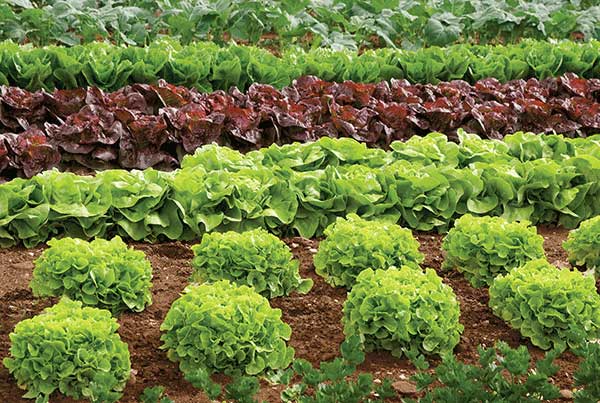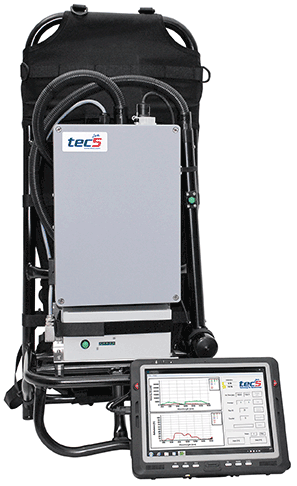Spectroscopy is a safe, nondestructive analytical method that can improve the quality control and assurance at production facilities by providing real-time, accurate measurement of the products at various steps to prevent larger quality issues.
STACEY CARRIER AND JUDE SCHNECK, TEC5USA INC.
Consumers expect that the food they purchase has been checked for potential health hazards. In today’s hyper-connected world, it’s becoming more important for a company to ensure the products it sends to market are safe, avoiding alarm and illness, both of which could cause irreparable harm to the company’s reputation.
The food and agriculture industries face many challenges in meeting both FDA regulations and customer expectations. The Food Safety Modernization Act, passed in late 2010, introduced new quality standards to the U.S. food supply with the intent of preventing a health crisis, rather than responding after people become sick. It includes the establishment of science-based standards for preventive quality controls in food facilities, the production and harvesting of fruits and vegetables, and mandatory FDA inspections to ensure compliance. The regulations set stringent guidelines to help detect defective or potentially hazardous materials in products before they are shipped to consumers. All food and agriculture companies, including companies importing products into the U.S., must have preventive measures in place to ensure their products are compliant with established regulations1.

One of the more recent stories about food contamination involves feces-tainted cilantro, which arose in 2012. Cilantro regulations include measures for handling the crops and a cleaning cycle prior to packaging. Personnel involved in handling the cilantro must use protective gloves and wash their hands prior to working with the crops. These procedures were put into place to minimize common contamination factors such as dirty hands, but do not account for extraneous factors. Without real-time monitoring and a science-based standard, it is difficult to catch problems prior to shipment to consumers. And without sufficient quality and tracking data, it is even more difficult to determine the root cause of the problem, as in the case of the tainted cilantro. Several years passed before the FDA identified the problem and tracked it back to its source. The Food Safety regulations could instigate science-based standards and prevention methods that will help avoid issues like this in the future2.
Current methods
The food and agriculture industries follow FDA-mandated guidelines for quality control and quality assurance of products before they reach the consumer. Traditional quality-testing solutions for both industries usually require the destruction of some of the product for lab tests. Lab testing can be a lengthy process. If the testing is on-site, the results can be obtained within a few hours, however; off-site testing means that it could be several days before the necessary results are given and the necessary quality assurances are met.
Two common analytical techniques used in the agriculture industry for a wide variety of analyses are chromatography and atomic absorption spectroscopy. Chromatography is useful for the separation of complex organic materials, while atomic absorption is used for elemental analysis. Both techniques require significant sample preparation, significant technical training and/or long delays in obtaining results.
In one example of FDA quality assurance regulations, a small number of insect parts is allowed in various foods. Several methods are used to determine the number of insect parts in grains, including cracking/flotation, acid hydrolysis, x-ray inspection and enzyme-linked immunosorbent assay (ELISA). Acid hydrolysis, commonly known as the insect fragment test (AACCI method 28-41A) is used by the FDA to define the regulatory standard and involves breaking down the grains without affecting insect particulates. When oil is added, the oil layer contains the unwanted elements which can then be examined microscopically3.

tec5USA’s HandySpec is used on field measurements of crops.
In the cracking and flotation method, grain samples are sifted based on diameter, crushed, and then treated with a mixture of isopropyl alcohol and heptane. Undesirable particulates are trapped in the heptane layer, which can then be examined4,5. X-ray analysis includes removing surface particulates from the grains and taking an x-ray. The images are then examined for insect-infected grains6.
The ELISA method uses an antibody that binds to the insect myosin7. Through a series of reactions, the liquidated sample produces a color whose intensity is proportional to the number of insects in the sample.
All of the above-mentioned methods demand samples be removed from the process and require time to analyze, making it difficult to incorporate real-time automation analysis. Often in these analyses, hazardous chemicals are used and require proper disposal techniques. Another pitfall of these methods is the requirement for a skilled technician to properly handle and analyze the samples.
In today’s society, companies are looking for faster ways not only to assure the quality of their products, but also to catch contaminations quickly. The best method would be an in-line, nondestructive method capable of providing immediate answers and not dependent on a technician to run a series of reactions or tests. One powerful solution is to use optical spectroscopic methods.
Optical spectroscopic methods
Spectroscopic methods measure the wavelength dependence of the interaction of light with matter. This interaction could be the amount of light absorbed by a sample, or the diffuse reflection of light off a sample, making spectroscopy a valuable tool for measuring a wide variety of liquids, solids and gases. By incorporating certain types of measurement heads and probes, it is possible to measure samples in-line without destroying any of the product and delaying the process.
Every compound is unique in its molecular composition and arrangement of atoms; therefore, each chemical will interact with light at different wavelengths. For complex agricultural and food applications, there has been strong interest in near-infrared (NIR) spectroscopic techniques. NIR spectroscopy ranges from 750 to 2500 nm and provides information about the different vibrations of the atoms within the molecules. Most organic compounds have unique signals in this region. Optical absorption measurements determine the concentration or purity of key ingredients in a nondestructive manner. Thus, the quality of a product can be assessed at almost any step of production.
Older spectroscopic methods often use a monochromator capable of detecting an individual wavelength, but use a moving grating or prism to scan through a spectral range. This method offers varying resolution between spectral features but may take a few minutes to gather the spectra. In certain processes, where samples can pass a spot in a few milliseconds, the long data-collection time makes the older methodology impractical. Newer methodology utilizes diode-array spectroscopy, which incorporates a detector array capable of capturing the entire spectral range without having to move a grating, and allows a spectrum to be collected in milliseconds.
In the dairy industry, NIR spectroscopy is used to monitor sugar, fat and water content of products. However, it is being done mainly at-line, where a sample is retrieved from a large tank and undergoes a spectroscopic analysis for information about the various qualities.
In the agriculture industry, spectroscopic measurement systems have been incorporated, for example, on tractors8 to monitor the nitrogen content of crops for more efficient fertilization. This method includes a feedback sensor that allows the system to determine whether it is necessary to dispense more or less fertilizer. For complex samples, it is often necessary to use statistical modeling, since most organic compounds absorb light in the NIR. A multivariate approach is necessary, as the spectra can include wavelength data over a thousand nanometer range, as well as comprise the many components in a sample.
For real-time analysis, the control of the instrument and the statistical model are incorporated into the control automation. If a sample is contaminated or shows certain deviations from a pre-existing standard, a warning signal is sent to the central control that something is wrong. Thus, for the recent cilantro crisis, spectroscopy may have been able to prevent the recall. If a spectroscopic technique had been integrated into the cleaning phase of production, it could have detected a deviation from the normal product, which would have allowed the producers to proactively fix the problem before the tainted food reached consumers.
The initial cost of installation and implementing in-line spectroscopic methods in quality assurance and control is high. It includes not only the cost of hardware but also the cost to build a robust statistical model for a supplier’s particular product.
However, these methods could help to avoid recalls and ensure that the quality of the product is consistent. Recalls can cause mass distrust for products involved, which hurts a brand’s image, as consumers must be reconvinced to use such a product. With in-line spectroscopic testing, a producer’s product quality and standard gain good reputations, because each item is tested rather than a small subset of the product. When a problem does arise, a company can boost consumer confidence and help ease the fear by being able to quickly pinpoint the issue, and take steps to prevent similar problems in the future.
Meet the authors
Dr. Stacey Carrier received her PhD degree in physical chemistry from the University of Wisconsin-Madison, and has specialized in UV-VIS, NIR and Raman spectroscopy. She is the spectrometer systems product manager at tec5USA Inc. in Plainview, N.Y., which sells high-quality spectroscopic equipment for process control; email: [email protected]. Dr. Jude Schneck received his PhD from Boston University, and has specialized in UV-VIS and NIR spectroscopy. He is the spectroscopic components product manager at tec5USA; email: [email protected].
References
1. Retrieved from www.fda.gov
2. A. Stapleton (July 28, 2015). FDA bans some cilantro from Mexico, cites human feces in fields. Retrieved from www.cnn.com/2015/07/28/health/mexico-cilantro/
3. AACC International Approved Methods. AACCI Method 28-41.03: Acid Hydrolysis Method for Extracting Insect Fragments and Rodent Hairs — Light Filth in White Flour. Retrieved from http://methods.aaccnet.org/summaries/28-41-03.aspx
4. AACC International Approved Methods. AACCI Method 28-51.02: Flotation Method, for Insect and Rodent Filth. Retrieved from http://methods.aaccnet.org/summaries/28-51-02.aspx
5. AACC International Approved Methods. AACCI Method 28-22.02: Cracking-Flotation Test for Internal Insects in Whole Grains. Retrieved from http://methods.aaccnet.org/summaries/28-22-02.aspx
6. AACC International Approved Methods. AACCI Method 28-21.02: X-Ray Examination for Internal Insect Infestation. Retrieved from http://methods.aaccnet.org/summaries/28-21-02.aspx
7. B. Brader, R. Lee, et al. (2002). A comparison of screening methods for insect contamination in wheat. Journal of Stored Prod Res, Vol. 38, pp. 75-86.
8. A. Link, J. Jasper, et al. (2004). Variable nitrogen fertilization by tractor-mounted remote sensing. Controlling Nitrogen Flow and Losses. Ed. D.J. Hatch, D.R. Chadwick, et al. Wageningen, The Netherlands: Wageningen Academic Publishers. pp. 188-190.